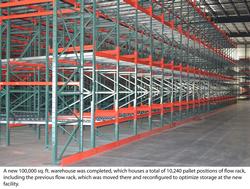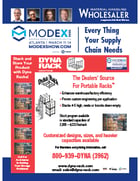
Flow storage system accelerates company’s expansion
Expanding business in a tough economy isn’t easy, but that’s how Crider makes it look, having just added a 100,000 sq. ft. warehouse to its Stillmore, Ga. facility to accommodate all the new business it’s getting. But before the company could continue expanding in the consumer goods marketplace, it first had to rethink its production and warehouse logistics.
“We’ve experienced tremendous growth over the past decade, resulting in our warehousing and logistics becoming a bottleneck,” says Mark Howell, Executive Vice President of Sales and Marketing at Crider, the market leader of canned chicken in the U.S., which offers canned meats and frozen, fully cooked chicken to a variety of customers. “We’d outgrown our old warehouse and offsite storage, and had finished product stored in virtually every square foot of available space. We had to streamline logistics to meet demand and continue growth.”
The company’s capacity was limited by empty pallets cluttering up production and by inefficient floor stacking of palletized product, which created inventory management, forklift access, and truck loading challenges.
“We had to move product to get to other product, which made first-in, first-out (FIFO) product rotation difficult,” explains Phillip Rehberg, Vice President of Operations at Crider. “Over-handling and over-stacking the pallets caused costly, unnecessary finished product damage. Forklift operators spent too much time searching for product to ship, which made staging and loading delivery trucks inefficient.”
Crider turned to Craft Equipment Company, a full line material handling distributor, and Steel King, a flow storage system and pallet rack manufacturer. To unclutter the production area and free up about 2,000 sq. ft. of space for more equipment, the Over-Dock Pallet Storage Rack by Steel King was implemented, according to Rehberg. Like a kitchen cupboard for the kitchen, this keeps empty pallets safely out of the way until needed in a specially designed, over the loading dock storage rack that accommodates empty pallets, skids or returnable shipping containers.
“To continue growth and clear the logistics bottleneck with maximum pallet rack space in a minimal footprint, a needs analysis showed that a warehouse dynamic flow storage system was the best choice for Crider,” explains Buddy Chadwell, Craft Equipment’s Vice President of Sales, who oversaw an initial existing warehouse improvement project, followed by an expansion, then a new warehouse project, using the SK3400 pallet flow system by Steel King.
In a flow storage system, dynamic flow rails are inclined in a static rack structure, allowing loads placed on one end to move by gravity on rollers to the unloading end, with speed controllers acting as gentle brakes. As a load is removed, the loads behind it move forward automatically.
Since the flow system depth, height, and width were limited only by the size of the facility and capabilities of the material handling equipment, it was a good fit for Crider’s high volume, space efficient needs. Once loaded, FIFO product rotation is automatic and the rack eliminates labor and fork truck operation to arrange loads. Forklifts are required only for the initial and final unloading. Since only two aisles are necessary, aisle space can be reduced by 75 percent and up to 100 percent more product can be stored than with traditional selective pallet racking.
Because of the success of the flow system in the existing warehouse, an initial system of 864 pallet positions was soon expanded to a system with 1440 pallet positions, according to Chadwell. More recently, a new 100,000 sq. ft. warehouse was completed, which houses a total of 10,240 pallet positions of flow rack, including the previous flow rack, which was moved there and reconfigured to optimize storage at the new facility.
“Instead of inefficiently floor stacking product two to three pallets high, now we can securely store product four pallets high and twelve deep with the flow storage system, which maximizes storage density,” says Rehberg. “Once a forklift operator places a pallet, it automatically flows by gravity into storage. The pallets have designated entry and exit lanes and storage locations. This optimizes inventory management, minimizes overhandling and product damage, and expedites truck loading and staging for delivery. Before the flow system and new warehouse, we might ship 16 truckloads on a good day. Now we can routinely ship 25 truckloads in less time with less labor.”
“To protect the efficient logistics of our new warehouse and flow storage system, we wanted rack that would withstand inevitable forklift impact over the years with minimal maintenance and production downtime,” adds Rehberg.
At Chadwell’s suggestion, Crider chose SK3000 pallet rack, a rugged bolted rack with structural channel columns, by Steel King. A number of rack features helped the company meet its strength, durability, and maintenance goals. Compared to typical racking, the pallet rack constructed of hot-rolled structural channel column with full horizontal-diagonal bracing offers greater frame strength, durability and cross-sectional area. All grade-5 hardware provides greater shear strength, and a heavy 7-gauge wrap-around connector plate ensures a square and plumb installation with a tighter connection and greater moment resistance.
For added protection against fork truck impact, Craft Equipment recommended and Steel King provided two protective products to further safeguard vulnerable rack areas. Steel Guard, a pre-fabricated modular protective railing, was installed to protect rack at warehouse intersecting aisles, a high damage area where forklifts frequently make turns. Also installed was Guard Dawg, a low profile guardrail, to protect rack down aisles.
“Our warehouse logistics, which was once a bottleneck, is now a competitive advantage that enables us to efficiently grow our business while meeting customers’ needs,” concludes Howell, who is quick to show Crider’s new warehouse and flow storage system to customers and sales prospects. “Once someone sees our investment, they have confidence in our ability to deliver.”









